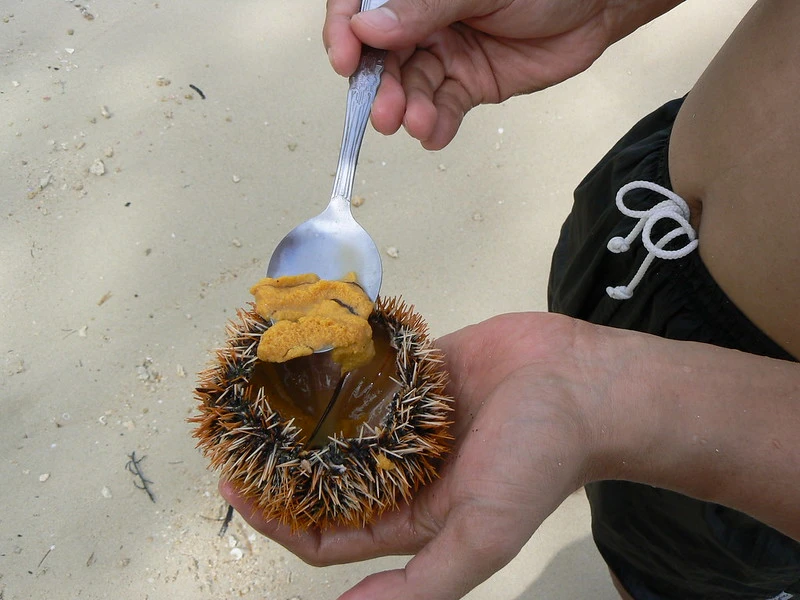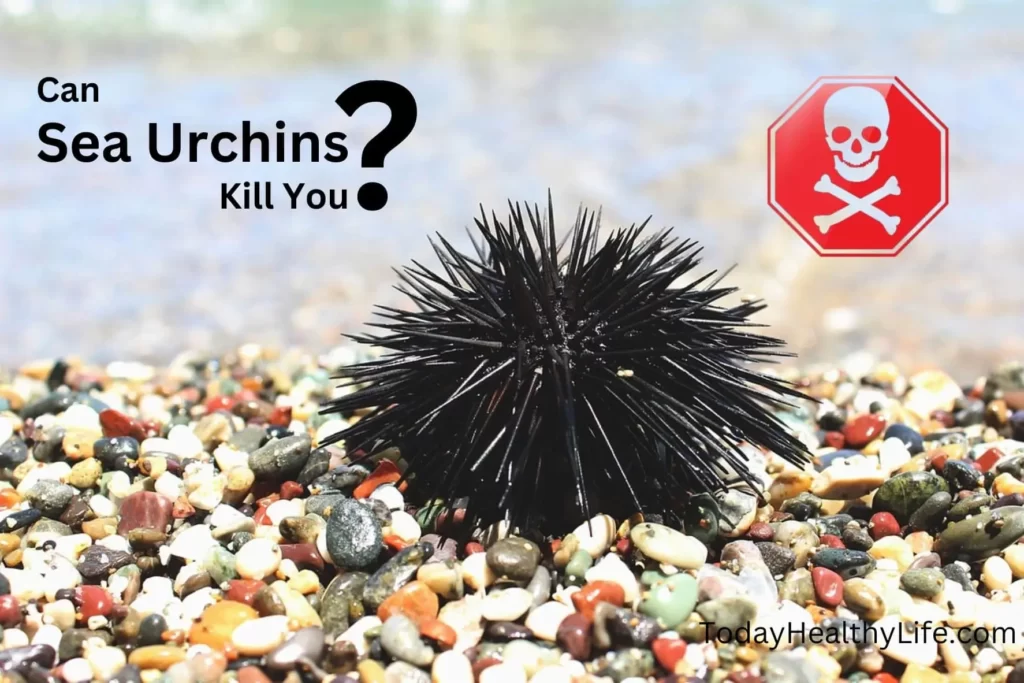When it comes to adventurous culinary experiences, few can rival the taste exploration of sea urchin.
Known for its striking appearance and often described as the “hedgehog of the sea,” the sea urchin is a spiky marine creature that hides a hidden gem within its spiny exterior – the prized sea urchin roe, also known as uni.
Universally revered by seafood connoisseurs and revered by sushi enthusiasts, sea urchin is an intriguing delicacy that inspires both fascination and curiosity.
In this blog post, we embark on a gastronomic journey to uncover the taste, texture, and culinary allure of sea urchin.
Table of Contents
A Prelude to Sea Urchin
Before we delve into the flavors of sea urchin, it is essential to understand the organism itself.
Sea urchins belong to the Echinoderm phylum, which also includes starfish and sea cucumbers.
These spiny echinoderms inhabit ocean floors around the world, from shallow coastal waters to the depths of the abyssal zone.
While over 900 species of sea urchins exist, the ones most often sought for their roe are the Red Sea Urchin (Mesocentrotus franciscanus) and the Green Sea Urchin (Strongylocentrotus droebachiensis).
Sea urchins have a distinct appearance, characterized by their spherical shape and long spines covering their entire surface.
They play an essential role in marine ecosystems as grazers, feeding on algae and other plant matter.
Despite their ecological significance, it is their vibrant roe that has captured the imagination of chefs and gourmands worldwide.
Read: What Do Mussels Taste Like?
The Culinary Gem: Uni Roe
Sea urchin roe, or uni, is the orange-yellow to pale yellow reproductive organ of the sea urchin.
The roe is primarily composed of the gonads of both male and female sea urchins.
Uni has been a prominent ingredient in Japanese and Mediterranean cuisine for centuries, and it has gained global popularity in recent years due to the rise of sushi and the growing interest in exotic delicacies.
To obtain uni, skilled divers harvest sea urchins by carefully removing them from their rocky habitats.
The roe is then carefully extracted, cleaned, and prepared for culinary use.
Chefs value fresh uni for its unique flavor profile and delicate texture, and it is often served raw or lightly seasoned to preserve its natural essence.
You may also read about: Eating Sea Urchin Side Effects, Benefits & More Information.
What Does Sea Urchin Taste Like?
Describing the taste of sea urchin to someone who has never experienced it is a challenging task.
The flavor of uni is often considered an acquired taste, with some people falling in love with its distinct brininess and others needing time to appreciate its complexity fully.

Several factors contribute to the flavor of sea urchin roe, making it an intriguing subject for food enthusiasts.
- Oceanic Essence: Uni’s primary flavor is undeniably “oceanic.” It captures the essence of the sea in a way that few other seafood items can. This characteristic taste is partly due to the sea urchin’s diet, which consists of seaweed, algae, and other marine vegetation. As a result, uni embodies the very essence of its underwater habitat.
- Briny Salinity: Sea urchin roe has a naturally salty taste, reminiscent of the sea’s brininess. This salinity adds a unique dimension to the flavor, distinguishing it from other seafood delicacies. The level of saltiness may vary slightly depending on the species of sea urchin and its specific environment.
- Umami Richness: Uni is celebrated for its umami, often referred to as the fifth taste alongside sweet, salty, sour, and bitter. The umami in sea urchin is a result of the presence of certain amino acids, such as glutamate. This richness contributes to the overall savory experience of indulging in uni.
- Creamy and Buttery Texture: Beyond its flavor, one of the most alluring aspects of uni is its lusciously creamy and buttery texture. The roe’s mouthfeel is akin to tasting a savory custard, making it an exquisite treat for the palate.
- Nutty Undertones: Some aficionados note the presence of subtle nutty undertones in uni, adding yet another layer of complexity to its overall taste profile. These nutty notes complement the brininess and contribute to the uniqueness of the culinary experience.
Read: What Does Swordfish Taste Like?
Culinary Applications of Sea Urchin
In culinary circles, sea urchin has earned a reputation as a luxury ingredient, served in various forms to showcase its natural flavors.
Here are some popular culinary applications of uni:
- Sushi and Sashimi: Perhaps the most well-known way to savor sea urchin is as nigiri sushi or sashimi. In these preparations, the fresh uni is served atop a small mound of seasoned rice or as a standalone delicacy, allowing diners to fully appreciate its unadulterated taste.
- Pasta and Risotto: Chefs often incorporate sea urchin into pasta dishes and risottos, adding a luxurious touch to these Italian classics. The uni’s creamy texture and oceanic flavor create a harmonious fusion with the other ingredients, resulting in a gourmet experience.
- Uni Toast and Crostini: Uni makes for an exquisite topping for toast or crostini. Its briny creaminess pairs exceptionally well with the crisp texture of the bread, creating a delightful contrast of flavors and mouthfeel.
- Uni Sauces and Broths: Uni can be used to prepare flavorful sauces and broths to elevate various seafood and non-seafood dishes. Its umami-rich essence enhances the overall depth of the dishes, creating a symphony of flavors.
- Uni Roe Omelet: A popular breakfast or brunch choice in some regions, the uni roe omelet combines the creamy goodness of the roe with the comforting familiarity of eggs, making for a comforting and indulgent meal.
Read: What Does Conch Taste Like? Side Effects & More.
Cultural Significance of Uni
In addition to its exquisite flavor, sea urchin holds cultural significance in various regions across the globe.
Here are a few examples:
- Japanese Cuisine: Japan is renowned for its appreciation of seafood, and uni holds a special place in Japanese cuisine. Often referred to as “uni” in Japanese, it is a prized delicacy served at sushi bars and high-end restaurants, and it is a symbol of luxury and refinement.
- Mediterranean Culinary Heritage: Sea urchin has been a part of Mediterranean cuisine for centuries. In some Mediterranean cultures, uni is traditionally consumed raw with a squeeze of lemon or as a key ingredient in seafood stews and pasta dishes.
- Ancient History: Sea urchin has historical significance, with traces of sea urchin consumption found in archaeological sites dating back thousands of years. This points to the enduring appeal of this marine delicacy throughout human history.
The Sustainability Debate
As sea urchin’s popularity has risen, so has the concern about its sustainability.
Overfishing and habitat destruction have led to declines in some sea urchin populations, raising questions about the long-term viability of harvesting these creatures for culinary purposes.
To ensure the future of sea urchins as a food source, sustainable fishing practices, ecosystem protection, and responsible harvesting must be prioritized.

You may also read about: Can Sea Urchins Kill You? Exploring the Intriguing Truths.
Related FAQs:
Yes, sea urchin is considered an acquired taste. Due to its distinct flavor and texture, not everyone immediately takes to the taste of uni.
Some people may find the briny, oceanic notes overwhelming initially.
However, with repeated exposure and an open mind, many individuals develop an appreciation for this unique delicacy and may come to love it over time.
Sea urchin is most commonly enjoyed raw or minimally seasoned to preserve its natural flavors.
One popular way to eat uni is in sushi or sashimi form, where it is served atop a small mound of seasoned rice.
It can also be used as a luxurious topping for toast, crostini, or added to pasta dishes and risottos to elevate their flavors.
Some cultures incorporate sea urchin into sauces and broths to enhance various dishes.
Pregnant women should exercise caution when consuming raw seafood, including sea urchin, due to the risk of foodborne illnesses and potential exposure to harmful bacteria or parasites.
It is generally advisable for pregnant women to avoid raw seafood and opt for fully cooked alternatives to ensure food safety.
When selecting fresh sea urchin, look for specimens with intact, firm shells and no visible signs of damage or decay.
The spines should be intact and evenly distributed.
For pre-prepared uni, opt for vibrant orange-yellow to pale yellow roe with a fresh, mild scent of the ocean.
Conclusion
So, what does sea urchin taste like? The taste of sea urchin, or uni, is an intricate blend of oceanic essence, briny salinity, umami richness, and creamy textures.
It is a culinary adventure that may not be for everyone, but for those with a taste for the exotic, sea urchin offers a delightful journey through the flavors of the sea.
Whether enjoyed as sushi, pasta, or simply served fresh, uni continues to captivate palates around the world, leaving a lasting impression that is truly out of this world.
If you ever find yourself presented with the opportunity to try sea urchin, I encourage you to take the plunge into this alien delicacy.
It’s a culinary experience unlike any other, a journey to the depths of the sea and a celebration of the ocean’s treasures.
Just as the sea urchin’s spiny exterior hides a coveted gem within, so too does the taste of uni hold a world of extraordinary flavors waiting to be discovered. Bon appétit!
Disclaimer: As with all seafood, consumption of sea urchin comes with the possibility of allergic reactions or health risks. If you have any allergies or health concerns, please consult a healthcare professional before trying sea urchin or any other unfamiliar food.

